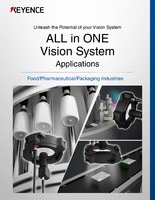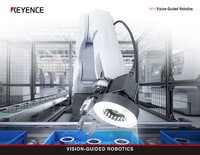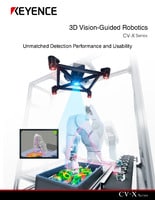Dimension Measurement
Dimension measurement
Dimension inspection is a type of appearance inspection. It plays an important role in making pass/fail judgments of whether parts or products have been worked or assembled according to specifications. These dimension inspections can be automated with image processing:
- Measuring maximum/minimum dimensions of parts or products
- Measuring maximum/minimum/average inner or outer diameters or center coordinates of O rings
- Measuring roundness or angle of the tips of metal parts
- Measuring positions of edges and labels
- Measuring widths of sheet/film products
Dimension measurement is the basis of inspection; however, it was difficult to introduce because it required large amounts of time and effort. With the expansion of factory automation (FA), dimension measurement using image processing has increased. This page introduces the basic principle, advantages and practical applications of dimension measurement using image processing.
Basic principle of dimension measurement for judging whether products have been worked in accordance with specifications
Advantages of introducing image processing
In general, the dimensions of parts and products are measured with microgauges or calipers or checked with inspection jigs to ensure that there is no variation in accuracy. Measurement using instruments such as microgauges or calipers inevitably involve errors due to individual differences among workers and measurement conditions. The result of checks with inspection jigs can be used for pass/fail judgment of whether the product is within the tolerance range or not. However, it does not show accurate measured values.
Other methods of dimension measurement include optical comparators, GD&T and profile measurement systems, and 3D measurement systems. They share the problems of requiring manual operation, and being both time consuming and expensive.
With image processing, various dimensions can be obtained from captured images. It is easy to measure the dimensions of various sections of parts and products based on this data and judge whether they are within tolerances. Another advantage is that you can measure angles or circle roundness simultaneously with the lengths of various sections, and save them as numerical data.
100% inspection for preventing oversight and outflow of defective workpieces
Dimension inspection using various measurement systems and jigs tends to require many offline processes. Consequently, 100% inspection incurs significant labor and costs. On the other hand, sample inspection has the possibility of inspection omission or outflow of defective workpieces. Dimension inspection using an image processing system can achieve inline dimension measurement of all targets. This ensures stable product quality while keeping costs down.
Faster inspection for improved productivity
Inline dimension measurement of parts and products allows significant reduction of inspection time. Image processing systems make inspection faster and contribute to productivity improvement.
Storage and management of quality information
Jig-based dimension inspection does not provide accurate measurement data. It only checks whether the dimension is within the tolerance range or not. Dimension inspection using image processing provides not only pass/fail judgment results but also numerical data of the accurate dimensions of multiple sections, and this data can be easily saved and managed. Such information can also be used effectively for traceability management or process improvement.
Basics of dimension measurement: Measurement based on edge detection
Measurement based on edge detection is generally used for dimension inspection using image processing. This section explains pixel resolution, the basics of sub-pixel processing, and the principle of edge detection to help understand edge detection.
Relationship between image resolution and judgment tolerance
The image pickup device of machine vision consists of an array of pixels. In dimension measurement, you can calculate the dimension tolerance based on this number of pixels and the field of view. An important factor for the calculation is pixel resolution, which is the actual length that corresponds to a single pixel of the image pickup device. The pixel resolution can be calculated with this formula:
Pixel resolution = Field of view in the Y direction [mm] / Number of pixels of the image pickup device in the Y direction [pixels]
For example, assume you use a 0.31 megapixel camera and a 2 megapixel camera. The number of pixels in the Y direction is 480 for the 0.31 megapixel camera and 1200 for the 2 megapixel camera.
When the field of view is 100 mm:
- 【0.31 megapixel】
- Pixel resolution = 100 mm / 480 pixels = 0.208 mm/pixel
- 【2 megapixel】
- Pixel resolution = 100 mm / 1200 pixels = 0.083 mm/pixel
- 【21 megapixel】
- Pixel resolution = 100 mm / 4092 pixels = 0.024 mm/pixel
The pixel resolution can be calculated in this way. The table below shows reference pixel resolution values of cameras used in typical image processing systems, from 0.31 to 21 megapixels.
Pixel resolution Reference value
| Field of view (Y direction)[mm] | |||||||||
|---|---|---|---|---|---|---|---|---|---|
| Number of pixels of the camera | 1 | 5 | 10 | 20 | 30 | 50 | 100 | 200 | 500 |
| 0.31 megapixel | 0.002 | 0.01 | 0.021 | 0.042 | 0.063 | 0.104 | 0.208 | 0.417 | 1.042 |
| 2 megapixel | 0.0008 | 0.004 | 0.008 | 0.017 | 0.025 | 0.042 | 0.083 | 0.167 | 0.417 |
| 5 megapixel | 0.0005 | 0.002 | 0.005 | 0.01 | 0.015 | 0.024 | 0.049 | 0.098 | 0.244 |
| 21 megapixel | 0.0002 | 0.001 | 0.002 | 0.005 | 0.007 | 0.012 | 0.024 | 0.049 | 0.122 |
- *Number of pixels in the Y direction of the CCD of a 0.31 megapixel sensor = 480 pixels
- *Number of pixels in the Y direction of the CCD of a 2 megapixel sensor = 1200 pixels
- *Number of pixels in the Y direction of the CCD of a 5 megapixel sensor = 2050 pixels
- *Number of pixels of the image pickup device in the Y direction of a 21 megapixel camera = 4092 pixels

In dimension inspection, the tolerance used as a threshold for differentiating good and defective workpieces is usually calculated in units of ±5 pixels. This is based on the assumption that the number of pixels that ensures stable tolerance judgment is about 10 times the repeatability. Since the repeatability of typical machine vision is about 0.1 pixel under ideal conditions, the practical repeatability is considered to be 0.5 pixel with some margin included. Multiplying this number by 10 yields ±5 pixels, and this value can be regarded as the minimum unit for tolerance setting. You can use this value to calculate the actual dimension tolerance with this formula:
Actual dimension tolerance [mm] = Pixel resolution (field of view in the Y direction) [mm] / Number of pixels of CCD in the Y direction x 5 pixels
- 【0.31 megapixel】
- Dimension tolerance = 0.208 mm/pixel x 5 pixels = 1.04 mm
- 【2 megapixel】
- Dimension tolerance = 0.083 mm/pixel x 5 pixels = 0.415 mm
- 【21 megapixel】
- Dimension tolerance = 0.024 mm/pixel x 5 pixels = 0.12 mm
You need to select machine vision and field of view that provides the required accuracy.
Tolerance judgment value
| Field of view (Y direction)[mm] | |||||||||
|---|---|---|---|---|---|---|---|---|---|
| Number of pixels of the camera | 1 | 5 | 10 | 20 | 30 | 50 | 100 | 200 | 500 |
| 0.31 megapixel | 0.01 | 0.05 | 0.1 | 0.2 | 0.3 | 0.5 | 1.0 | 2.1 | 5.2 |
| 2 megapixel | 0.004 | 0.02 | 0.04 | 0.08 | 0.1 | 0.2 | 0.4 | 0.8 | 2.1 |
| 5 megapixel | 0.002 | 0.01 | 0.02 | 0.05 | 0.07 | 0.1 | 0.2 | 0.5 | 1.2 |
| 21 megapixel | 0.001 | 0.006 | 0.01 | 0.02 | 0.04 | 0.06 | 0.1 | 0.2 | 0.6 |

Basics of sub-pixel processing
As explained above, the pixel resolution is the actual dimension value of one pixel. In reality, however, dimension measurement using image processing can show dimensions to units less than a pixel through approximate calculation. This is called sub-pixel processing.
A sub-pixel is a unit smaller than a pixel. For example, KEYENCE's image processing offers dimension data in units of 1/1000 pixel.

Principle of sub-pixel processing
The sub-pixel processing detects an edge where the contrast changes between bright and dark, converts it into a projection waveform, and then performs differential processing. The peak of the differential waveform is determined as an edge point.

Dimension measurement based on edge detection
Edge detection is especially important for dimension measurement using high pixel resolution (high precision). This section describes the basic flow of edge detection.
1. Projection
Scan the target perpendicularly to the detecting direction to obtain the average shade of the projection lines. The average shade waveform of the projection lines is called a projection waveform.


2. Differentiation
The differentiation of the projection waveform shows larger differential values for points that might be edges. Differentiation is a process for finding changes in shades (gradation levels).

Differential waveform (edge strength waveform)
3. Correction to make the maximum differential value 100%
Apply correction so that the maximum differential value and absolute value become 100% to stabilize the edge. The peak of the differential waveform that exceeds the specified edge sensitivity is determined as an edge point.

4. Sub-pixel processing
Calculate the waveform of three pixels, one at the peak of the differential waveform and two adjacent pixels, and measure the edge position in units of 0.001 pixel.

Practical applications
As factory automation increases, saving time in inspection has become a challenge, and the same holds for dimension measurement. Measuring using image processing has become the main technique for this kind of process improvement.
Inspection of various dimensions of chip capacitors
In addition to the diameter and length of the capacitor body, its parts can be divided into segments to perform edge position detection and obtain the minimum diameter of a narrowing part or the length or bend of a lead wire. The dimensions of each part can be measured accurately.

Inspection screen


Dimension measurement of bottle mouths
Dimensions can be measured accurately even when used inline. For example, you can capture an image of a PET bottle moving on a line from the side and measure the dimension of the bottle neck ring to detect defective molding, incorrect type, or assembly failure. This kind of Inline dimension inspection improves efficiency.

Inspection screen

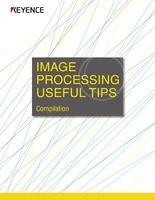

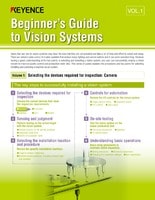

![A Technical History of Image Processing Vol.1 [Camera]](/img/asset/AS_46814_L.jpg)
![The Latest Image Processing Applications [Transportation Industry]](/img/asset/AS_71759_L.jpg)
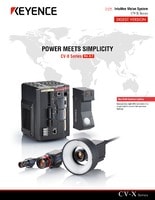
![The Latest Machine Vision Inspections [Food and Medical Industries]](/img/asset/AS_72814_L.jpg)

